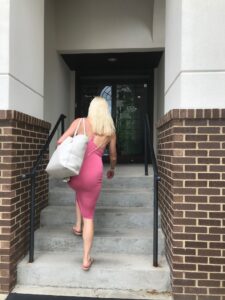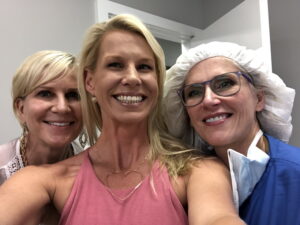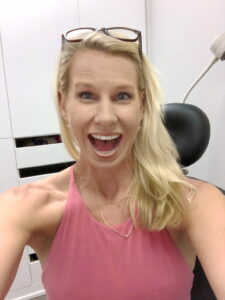Dr. Horton’s Breast Augmentation Journey Part V – The Preoperative Visit

At my preop visit, the day before my breast augmentation procedure, I met first with Dr. Haws’ Nurse who educated me about what to expect the day of surgery, reviewed my recovery and postoperative restrictions, and took preoperative photographs.


In my San Francisco Plastic Surgery practice, I don’t use morphing software to help patients determine their desired breast implant size. Instead, I ask patients to find “wish pictures” to help decide which implant type/size/width/projection is best for my patients (see the second blog in this series for my wish pictures!). I refer to my patients’ wish pictures intraoperatively and use a temporary intraoperative sizer to determine the best implant for each breast, individually.

It was interesting to see my images uploaded to the computer screen and to witness the changes when difference implant volumes were typed in. Since I’m a Board Certified Plastic Surgeon who specializes in breast augmentation, I had a pretty good idea of what implant I wanted for my own body!
Dr. Haws and I had decided that around 300 cc was appropriate (which is “just more than a cup of milk”, 250 cc). We also knew that a slightly larger implant would be required on the right than the left, as my left breast was slightly larger than my right.
100% of breasts are different sizes before surgery, and at least 2/3 of my breast augmentation patients require subtly different implant sizes to achieve symmetry. Breasts are “sisters, not twins”. The estimated volume difference was 15 to 35 cc different, one side to the other. To put this into perspective, 30 cc is one ounce (or a shot of tequila 😉 ).

Signing my surgical consents. Although I go through everything in detail with my patients before surgery, it was a good experience to be on this end.
I didn’t have many questions, as I educate patients several times weekly about breast augmentation at their consultation and review recovery questions at their preoperative visit, which is a week or two before surgery. The only difference in this appointment was that I brought my own drains – yes, “BYOD”!

Don’t we all feel this way sometimes? Humor is a great way to alleviate anxiety before surgery. Except I had none!
I felt it was important for me to have drains, as I insert drains at every breast augmentation procedure I perform. “Drains are your friends!” is what I tell patients, as they decrease the risk of complications such as infection and capsular contracture by gently whisking away wound fluid as you heal. Dr. Haws does not normally use drains, and while I respected her expertise and personal professional technique and didn’t want to tell her how to do my surgery, she agreed to put in drains at my request.

I reminded her how to insert them, as it had been years since she has used them! I left the preoperative visit excited, reassured and confident in my decision and choices.

Three women Plastic Surgeons, and one patient. Dr. Mary Gingrass & Dr. Melinda Haws and Dr. Karen Horton

“Before”

Excited!
Subscribe to my blog to learn more – details about my surgery, the recovery and final results one year later!
